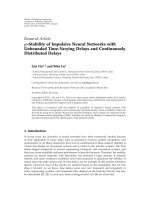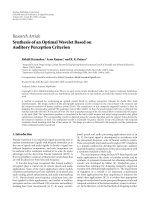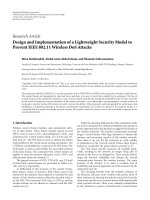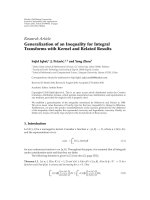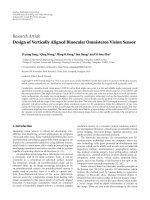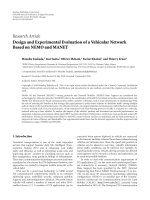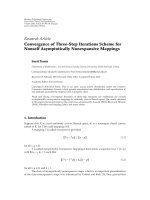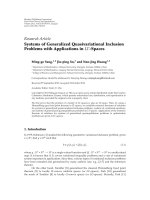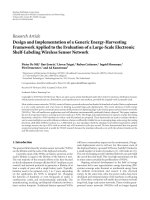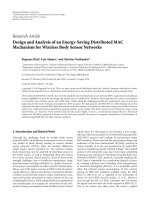Báo cáo hóa học: "Research Article Design of an Omnidirectional Multibeam Transmitter for High-Speed Indoor Wireless Communications" doc
Bạn đang xem bản rút gọn của tài liệu. Xem và tải ngay bản đầy đủ của tài liệu tại đây (3.57 MB, 11 trang )
Hindawi Publishing Corporation
EURASIP Journal on Wireless Communications and Networking
Volume 2010, Article ID 728468, 11 pages
doi:10.1155/2010/728468
Research Article
Design of an Omnidirectional Multibeam Transmitter for
High-Speed Indoor Wireless Communications
Jaw-Luen Tang and Yao-Wen Chang
Department of Physics, National Chung Che ng University, Chiayi County 62102, Taiwan
Correspondence should be addressed to Jaw-Luen Tang,
Received 30 October 2009; Revised 17 April 2010; Accepted 9 May 2010
Academic Editor: Anthony C. Boucouvalas
Copyright © 2010 J L. Tang and Y W. Chang. This is an open access article distributed under the Creative Commons Attribution
License, which permits unrestricted use, distribution, and reproduction in any medium, provided the original work is properly
cited.
For future high speed indoor wireless communication, diffuse wireless optical communications offer more robust optical links
against shadowing than line-of-sight links. However, their performance may be degraded by multipath dispersion arising from
surface reflections. We have developed a multipath diffusive propagation model capable of providing channel impulse responses
data. It is aimed to design and simulate any multibeam transmitter under a variety of indoor environments. In this paper, a
multi-beam transmitter system associated with hemisphere structure is proposed to fight against the diverse effects of multipath
distortion albeit, at the cost of increased laser power and cost. Simulation results of multiple impulse responses showed that
this type of multi-beam transmitter can significantly improve the performance of BER suitable for high bit rate application. We
present the performance and simulation results for both line-of-sight and diffuse link configurations. We propose a design of
power radiation pattern for a transmitter in achieving uniform and full coverage of power distributions for diffuse indoor optical
wireless systems.
1. Introduction
In recent years, the development of indoor optical wireless
communication system has received great attention due
to its capability for future high speed and flexible optical
communications at low cost [1–11]. Wireless optical link
can also offer a secure and a promising alternative to radio
communications for wireless indoor applications. Indoor
optical wireless network (such as Infrared links) can be
classified as several configurations for link design.
In simple infrared links the classification is normally
based on the directionality and line-of-sight (LOS) between
the receiver and transmitter [7, 8]. In LOS link system, optical
carrier from the transmitter reaches the receiver directly,
while in non-LOS link system, an optical carrier reaches the
receiver after some diffusive reflections by the ceiling and/or
walls in the room. Directed LOS links are the most widely
used IR links and offer low path loss, but require precise
alignment of the transmitter/receiver and are susceptible to
blockage of the beams. Nondirected non-LOS links, also
known as diffuse links, where the optical carrier is reflected
diffusively to omnidirection and fills the whole room can
avoid the need for aiming the transmitter and provide
robustness against shadowing due to the blockage, but suffer
from increased path loss and data-rate limitation caused by
multipath reflections. Hybrid systems, where the t ransmitter
and receiver have different degrees of directionality, are
commonly used to improve the link performance. Diffusive
systems, such as diffuse indoor IR wireless system, are
referred to those systems using a combination of nondirected
and non-LOS transceiver configurations.
One of the key issues in nondirected diffuse optical
wireless communications is to design an omnidirectional
highspeed multibeam transmitter that can overcome the
shortcomings occurred in indoor wireless local-area network
(WLAN), such as ambient radiation interference, detector
noises, wall reflections, and multipath dispersion [2, 3, 10–
17]. In addition, substantial nonuniform power distribution
at various points in a room is also a problem for the
diffuseindoorIRwirelesssystem.Therehavebeena
number of studies [18–33] explored to solve this power
nonuniformity problem, in which most of them suggested
the use of multiple transmitter associated with multispot
diffusing imaging or nonimaging receivers. For example,
2 EURASIP Journal on Wireless Communications and Networking
Carruthers and Kahn [20] have proposed angle diversity
technology by using multiple narrow beam transmitter and
multiple nonimaging receivers. The advantages of these types
of systems are high ambient light rejection and reduced
multipath distortion due to the use of narrow FOV detector
in the receivers. Later, Kahn et al. [21] reported the use
of imaging diversity receiver to reduce ambient light and
path loss. Djahani and Kahn [13, 22]haveusedmultibeam
(quasidiffusive) transmitters and imaging diversity receivers
to improve the link performance for both LOS and non-
LOS IR links. The link performance is quantified as the
transmitted power required for achie ving a bit error rate
(BER) not exceeding 10
−9
with 95% probability. The system
can reduce the required transmitted power by up to 13 dB
in LOS links and more than 20 dB in non-LOS links. Al-
Ghamdi and Elmirghani [27–30] have analyzed the perfor-
mance of IR links by using a line strip multibeam transmitter
combined with angle diversity receiver. With this system,
they demonstrated that h igh performance can be achieved
due to the significant reduction in background noise and
inter symbol interference (ISI) effects as well. Other systems
also show some promising results by either increasing signal-
to-noise ratio or reducing path loss/multipath dispersion
such as holographic diffusers [18], multispot diffusing using
holographic diffusing spot array generator [22–24], multiple
transmitters [19], and multiple optical sources [24].
Most of the above approaches exploited so far to some
degree are quite complicated and require sophisticated
transceiver system and demodulation scheme. Out of them,
the one utilizing multiple or multibeam transmitters is
relatively simple and quite appealing as it can produce near-
uniform power distribution and mitigate the shadowing
effects. Additionally, it can overcome the drawbacks and
combines the advantages of both LOS links and diffuse links.
The power levels of the transmitters can be carefully adjusted
to meet the eye safety standards. Bakalidis et al. [19] and Yang
and Lu [26] have shown that near uniform optical power
distribution (within the working range of the receivers) is
possible when a number of transmitters were placed in a
predefined square grid (or pixel) near the ceiling of the room,
assuming the delay dispersion of such a source configuration
is negligible. The ratio of the maximum to minimum
receivedpoweristermedasdegreeofuniformityandisused
as a measure of the amount of power variations on the floor.
In our work, we propose a multibeam transmitter mounted
on the ceiling and a single-element receiver located on the
floor pointing toward the ceiling. In this configuration, the
optical signal communication between the tr ansmitter and
receiver can occur only through the reflected rays from the
ceiling/walls. The system has the potential of providing a
fieldofview(FOV)ofnearsemisphereor180degreewith
sufficient power level.
To combat the adverse effects of multipath dispersion
for high bit r a te system, accurate propagation models are
essential and needed. The power distribution in a room
can be simulated accurately using the impulse response
of the channel. The channel impulse response is used
to analyze and compensate for the effects of multipath
temporal dispersion [9].Therehavebeensomealgorithms
developed for this purpose, such as the recursive method [9],
statistical approach [34], DUSTIN algorithm [35], Monte
Carlo calculation [36], Modied Monte Carlo Scheme [37],
Ceiling bounce model [38] and Iterative Site-Based Modeling
[39], and Modified recursive method [31, 32]. The recursive
method by Barry et al. [9] is most commonly used for
the single transmitter environment and it agrees well with
experimental results. We extended this recursive method to
evaluate the impulse response suitable for the multibeam
(multielement) transmitter environment and in some way
it is similar to the modified recursive method developed by
Sivabalan and John [31, 32].
In this paper, we present a multipath diffusive propa-
gation model [40], which is aimed to design and simulate
infrared wireless transceiver under a variety of indoor
environments. Based on ray tracing algorithms this com-
puter code calculates the impulse responses of an arbitrary
room filled with Lamber tian optical sources and reflectors.
The method described here in principle can calculate the
impulse response accounting for any number of reflec-
tions from any number of optical sources assembled by a
single multibeam transmitter configuration. This allows a
fairly accurate analysis of power distributions and impulse
responses. The method can further be easily modified to
incorporate the effects of angle diversity reception with
an imaging receiver, but at the cost of several tens times
of computing time. We have investigated the spatial and
temporal power distributions of several possible multibeam
transmitter configurations in a room with multiple reflectors
such as wall, ceiling, and floor. Simulation results for both
LOS and diff
use link configurations are presented. The
results can be applied to design and select the optical
transmitter that overcomes the drawbacks encountered in
those links and provides the full coverage of field of view as
well as the power receiving performance.
A prototype multibeam transmitter suitable for produc-
ing uniform, near hemisphere or 180 degree, high speed,
and long distance infrared radiation is proposed, and the
simulation results is shown. The method presented here can
also be applied for the design and simulation of fiber launch
system to achieve high bit rate and low noise performance in
fiber optical communications.
2. Channel Modeling and Simulation
Algorithms
Shown in Figure 1 is the system model of nondirected diffuse
optical wireless channel system with the proposed multibeam
transmitter in an indoor environment. The transmitter is
located on the ceiling, while the receiver is on the floor
of the same room. The simulation scenery of diffusive
optical channel presented in this paper is in an empty
rectangular room, a lthough our techniques can be extended
to other shape of rooms. Note that the simulation model
and technique reported here can also be applied for any
transmitter system in optical fiber communications. The
wireless channel model, as described below, includes optical
source, surface reflector, and photodiode receiver.
EURASIP Journal on Wireless Communications and Networking 3
Wall
Receiver
Receiver
Receiver
Coverage area
Diffuse multi-beam
transmitter
Figure 1: System model of nondirected diffuse optical channel with
a multibeam transmitter.
2.1. Optical Source and Surface Reflector Models. An optical
source or a multibeam transmitter is modeled by a position
vector r
s
, an orientation unit vector n
s
, a total average power
P
s
and a radiation intensity pattern P(φ). The radiation
intensity pattern is defined as the optical power per unit solid
angle emitting from the source at position r
s
with an angle φ
with respective to its surface normal vector
n
s
. We model the
source using a generalized Lambertian radiation pattern of
order N with uniaxial symmetry [3]:
P
φ
= P
s
(
N +1
)
2π
cos
N
φ
rect
φ,
π
2
, φ ∈
−
π
2
,
π
2
,
(1)
where P
s
is the total emitting power or ir radiance of the
source, and φ is the emitting angle or the angle with respect
to source surface normal. The order N or mode number of
the radiation lobe specifies the directionality of the source
and is related to half-power sermiangle Φ
1/2
of the source by
N
= ln 2/[ln(cos Φ
1/2
)]. A traditional Lambertian source has
amodeofN
= 1. In particle, such beam can be generated
using optical diffusers or computer-generated interference
hologram.
To simplify the simulation, we assume al l reflectors
are purely ideal diffusive Lamber tian source with N
= 1,
although true reflections in general include both specular
and diffusive [41]. Several experimental measurements have
verified that many typical materials such as plaster walls,
carpets, and unvarnished woods can be approximated as
Lambertian reflectors very well [42, 43]. The radiation
intensity pattern P(φ) emitted by a differential element of an
ideal diffusive reflector is independent of the incident angle
of the lig h t source. The power received by a sufficiently small
receiver or reflector with a detecting area dA, can be shown
to be
dP
=
1
r
2
P
(
N +1
)
2π
cos
N
φ
cos
(
α
)
rect
φ,
π
2
dA,(2)
where φ and α are the emitting and incident angles,
respectively, and r is the distance between transmitter and
receiver, as illustrated in Figure 2. The surface reflector then
becomes a secondary source and re-emits power into space.
FOV
n
R
Receiver
n
S
Source
α
r
φ
A
R
x
y
z
cos(φ)
cos
3
(φ)
cos
30
(φ)
Figure 2: Geometry of optical source model with Lambertian
radiation pattern and receiver model.
The power radiated by the reflecting surface dA depends on
its reflection coefficient ρ and is assumed to be independent
of the incident angle α. The radiation pattern from the
reflecting surface again is a Lambertian with mode number
N
= 1andadifferential power distribution of ρdP into the
free space.
2.2. Receiver Model. The receiver model consists of an optical
lens system or concentrator, a photodetector, and a signal
processing unit. The optical system to collect the radiation
from the source is assumed to be ideal. The receiver mode is
specified by a p osition vector r
R
, an orientation unit vector
n
R
, a receiving effective area A,andfieldofview,definedasa
scalar angle such that a receiver only detect light radiation
whose angle of incidence is inside the FOV. This model
calculates current signal and noise received by the detector.
The photon current signal at the detector includes the optical
signal input, background and dark current. In general, the
photon current can be written as the sum of input signal
R
s
s(t) and noise n(t):
I
(
t
)
= R
s
s
(
t
)
+ n
(
t
)
,(3)
where R
s
is detector responsivity. The background noise n(t)
is modeled as white and Gaussian noise, and independent
of the input signal. The averaged current signal s(t), a
convolution integ ral of received power x(t) and system
impulse response function h(t), measured by the detector is
given by
s
(
t
)
=
∞
−∞
x
(
τ
)
h
(
t − τ
)
dτ. (4)
The received power at the detector contains a transmitted
power P
s
from the optical signal and a background radiation
P
bg
received at the detector. The noise is determined by
the variance in current noise at the detector for receiving
any optical signal. The photon-generated noise or shot-noise
variance in the detector that results from the received signal
is
σ
2
ss
= 2qR
s
P
s
Δ f ,(5)
4 EURASIP Journal on Wireless Communications and Networking
where q is the electron charge and Δ f is the electron
bandwidth. The following parameters are used: R
s
= 0.5 A/W
and Δ f
= 100 MHz. The variance in current at the detector
that arises from background radiation P
bg
is given by
σ
2
bg
= 2qR
s
P
bg
Δ f. (6)
The current variance in the detector that arises from the dark
current of the photodiode can b e expressed by
σ
2
dc
= 2qR
s
I
dc
Δ f ,(7)
where I
dc
is the dark current (∼1 nA) in the detector. In
addition, the current variance in the detector that results
from Johnson (thermal) noise is given by
σ
2
js
=
4kTΔ f
R
L
,(8)
where F is the noise figure of the system, and T is the
equivalent temperature, and R
L
is the load resistance. The
Johnson noise is modeled with the following parameters: T
= 300 K and R
L
= 10kΩ. From (5)–(8), the total variance in
current noise in the detector is given by
σ
2
tot
= σ
2
ss
+ σ
2
bg
+ σ
2
dc
+ σ
2
js
. (9)
When the shot noise is the dominant noise source, the total
noise variance can be approximated as σ
2
tot
≈ σ
2
ss
.
2.3. LOS and Diffusive Impulse Response. Assuming that the
distance r(x, y, z) between the transmitter and receiver is
much greater than the effective receiving area of the detector,
the received power at the detector is approximately a constant
over the surface of the receiver. The LOS impulse response in
an environment with no reflectors can be evaluated as
h
(
r, t
)
=
1
r
2
P
(
N +1
)
2π
cos
N
φ
cos
(
α
)
rect
φ,
π
2
×
dAδ
t −
r
c
.
(10)
Taking the diffuse reflection into account, the impulse
response of the optical channel is comprised of an LOS
component and a diffusive (non-LOS) component, h
tot
(t) =
h
LOS
(t)+h
diff
(t − ΔT). The surface power-delay illumination
pattern can be obtained by dividing walls and other reflecting
surfaces into pixels and then rays are traced across surfaces
between pixels. The initial surface illumination pattern at
Cartesian coordinates, due to the optical source, is calculated
by
I
(1)
t, x, y, z
=
h
tot
t, x, y, z
. (11)
The overall impulse responses, a summation of pr imary
source and subsequent illumination due to secondary
sources, can be calculated as
I
(k)
t, x, y, z
=
n
n=i
h
tot
t; I
(k−1)
; k>1. (12)
source
Receiver
FOV
x
y
z
Figure 3: A diffusive optical link with the geometry of source and
receiver and ray tracing between reflector and receiver pixels.
where I
(k−1)
is the response from (k − 1) reflections and
n is the total number of pixel elements. For a multibeam
transmitter equipped with m sources the channel response
function can be computed a s follows [31, 32]:
h
(
t
)
=
m
l=1
∞
n=1
I
(k)
(
l
)
t, x, y, z
. (13)
The tracing of optical rays is up to 5 reflections for time
duration of 200 ns to sufficiently simulate the multipath
propagation. After the surface illumination pattern is eval-
uated, the impulse response of a particular receiver can be
determined by ray t racing elements from the receiver to the
respective reflectors.
Given the distribution of transmitted optical power we
can thus estimate the received optical power from (13). For
transmitted power P
tx
with a unit Dirac delta function, the
average received power P
rx
is P
rx
= P
tx
H(0), where H(0) =
∞
−∞
h(t)dt.
2.4. Signal-to-Noise Ratio (SNR) and Bit Error Rates (BER).
We assume here that the receiver transmits at bit rate using
on-off keying (OOK). Among all modulation techniques for
wireless infrared links, OOK is the simplest to implement.
In a single receiver, the average signal-to-noise ratio (SNR)
is defined as the ratio of the reviced signal to the avgerated
noise and is expressed as
SNR
=
(
R
s
P
s
)
2
σ
2
tot
. (14)
It can be seen that when the shot-noise in (6) is the dominant
noise source, then the SNR is proportional to the square of
the detector area. This is because the numerator is always
proportional to the square of the detector area and the
shot noise variance is always proportional to the detector
area. Hence, if shot noise is dominant, then the SNR is
proportional to the detector area. Assuming OOK with
equiprobable zeros and ones, the BER is evaluated as
BER
= Q
SNR
, (15)
EURASIP Journal on Wireless Communications and Networking 5
50
100
150
200
250
300
350
400
450
500
550
2
3
(m)
2
(m)
(m)
(nW)
x
y
z
(a)
50
100
150
200
250
300
350
400
450
500
550
20
40
60
80
100
120
140
160
180
200
20 40 60 80 100 120 140 160 180 200
x (cm)
z (cm)
P(nW)
(b)
Figure 4: The surface power distributions with rays tracing for one reflection for (a) three walls and (b) one wall.
where
Q
(
x
)
=
(
2π
)
−1/2
∞
x
exp
−
y
2
/2
dy. (16)
For example, an SNR of 36 (15.6 dB) is required to achieve a
BERof10
−9
.
2.5. Channel B andwidth. The bandwidth of the indoor
channel is computed from the Fourier transform of the
channel impulse responses as
H
(
ω
)
=
∞
−∞
h
(
t
)
e
iωt
dt ≈
∞
−∞
h
(
nΔt
)
e
iωΔt
Δt,
H
(
ω
)
= ΔtH
exp
(
iωΔt
)
,
(17)
where H(exp(iωΔt)) is the discrete-time Fourier transform
of the discrete time signal h(nΔt). These results are used to
plot the normalized amplitude
|ΔtH(e
iωΔt
)| versus frequency
f and from which the 3 dB channel bandwidth is obtained.
3. Results and Discussion
3.1. Surface Illumination of a Single-Beam Transmitter. A
computer program was written using MATLAB software
package that implements the algorithms presented in the
previous section. Simulations were perfor med using ray
tracing approach for a typical diffusive optical channel, as
illustrated in Figure 3 , where a d iffusive optical source with
a divergent angle of 30 degrees is used to emit light radiation
into a rectangular empty room. We assign the direction of
north with x axis and the direction of west with y axis.
The elevation angles are measured with respective to the
horizontal plane, such that a source pointing straight down
has an elevation angle of 90 degrees, and a receiver pointing
straight up has an elevation of
−90 degrees. The azimuth
angle at position r is defined as the angle between x axis and
the projection of r vector onto the x-y plane. The choice of
time interval Δt or the bin width of the power histogram
that approximates the impulse response w ill determine the
computing time of simulation. The time interval of 2 ns is
used in this case.
The walls and other reflecting surfaces of the room
are segmented into square pixel size of 1 cm
2
and rays
are traced across surfaces between pixels to calculate the
surface power-delay illumination pattern. The optical source
or transmitter is positioned on the ceiling (x
= 1m, y =
1.5 m, z = 2 m), emitting with an elevation angle of θ =
30 degrees and an azimuth angle of φ = 0degrees.The
transmitter in our simulation setup was a highspeed 850 nm
light emitting diode (LED) with a spectral bandwidth of
50 nm, which emitted an optical beam with an approximately
Lambertian radiation pattern. The typical response time for
the transmitter was 5 ns. A wide angle receiver (180 degrees
FOV) consisted of a silicon photodiode with 1 cm
2
collection
area is located on the floor (x
= 1.0 m, y = 0m, z = 0m).
The typical rise/fall time for the receiver was 10 ns. The
reflection coefficients for walls, ceiling and floor are 0.8. The
order of Lambertian used in this simulation is N
= 1. Two
configurations were considered in this simulation (i) a small
room with dimensions of 2.0
× 3.0× 2.0 (m), and (ii) a l arger
room with dimensions of 10.0
× 5.0 × 2.0(m).Table 1 lists
the room dimensions and simulated parameters.
Shown in Figure 4 are the surface power distributions of
three walls for the small room simulated with ray t racing to
only one reflection from the pixel element, while for that of
Figure 5 the number of reflections is up to 5. The surface
power distribution shown in Figure 5 is calculated as
P
x, y, z
=
t
5
k=1
I
(k)
x, y, z; t
. (18)
Figure 6(a) shows the surface power dist ributions of three
walls for the larger room when an LOS optical line was
used. For a nondirected diffuse line, the sur f ace power
distribution pattern is shown in Figure 6(b). The power
distribution pattern depends largely on the propagation path
and multiple reflections across the room. For the case of LOS
simulation, a 3.2 dB power variation was obtained with a
maximum power of 80 μW received when the receiver was
6 EURASIP Journal on Wireless Communications and Networking
x
y
z
2
3
1
2
3
4
5
6
7
2
(m)
(m)
(m)
(nW)
(a)
P(nW)
20
40
60
80
100
120
140
160
180
200
0.5
1
1.5
2
2.5
3
3.5
4
4.5
20 40 60 80 100 120 140 160 180 200
x (cm)
z (cm)
(b)
Figure 5: The surface power distributions with rays tracing up to 5 reflections for (a) three walls and (b) one wall.
(m)
(m)
x
y
z
0.5
1
1.5
2
2.5
5
3
10
(m)
×10
5
(nW)
(a)
500
1000
1500
2000
2500
3
5
10
(m)
(m)
(m)
(nW)
x
y
z
(b)
Figure 6: The surface power distributions of the walls for (a) LOS simulation and (b) nondirection diffuse simulation.
Transmitter
θ
φ
x
z
(a)
Transmitter
θ
φ
x
y
z
(b)
Figure 7: Multibeam transmitter structures for (a) 180-degrees ring shape and (b) hemisphere.
Table 1: Simulation parameters for a typical diffusive optical channel with one transmitter located at the ceiling.
Parameter
Value
Transmitter elevation angle and azimuth angle (θ, φ)
(30, 0) (degrees)
Transmitter position: (x, y, z)
(1, 1.5, 2) (m)
Room dimension: length, width, height
(i) 2.0
× 3.0 × 2.0(m)
(ii) 10.0
× 5.0 × 2.0(m)
Reflection coefficients
Walls, ceiling, floor: 0.8, 0.8, 0.8
Number of reflections or bounces
5
Pixel size
0.01
× 0.01 (m)
Time interval Δt
2ns
EURASIP Journal on Wireless Communications and Networking 7
placed at the middle of the room. While for power coverage
relying on the reflectivity of the ceiling and walls, a large
path loss was observed due to the lack of a LOS optical path.
Amaximumreceivedpowerof2.5 μW was observed with a
2.5 dB variation in optical power across the room.
3.2. Design of Multibeam Transmitter. To achieve a near 180-
degree omnidirectional transmission and reduce multipath
distortion from numerous reflections, five configurations
of multibeam transmitter design, as illustrated in Figure 7,
were proposed. The parameters of these five configurations
(labeled as A, B, C, D, and E) are shown in Table 2.The
first multibeam transmitter or configuration A, illustrated
as Figure 7(a), forming a shape of ring on a horizontal
plane (xy plane), is constructed by 12 nonoverlapping
transmitters such that each t ransmitter has the same ele-
vation angles θ’s but different azimuth angles φ’s. The
azimuth angles are arranged such that the angle separation
between any two nearest neighborhood transmitters is 30
degrees. In xy plane, the proposed multibeam transmitter
(configuration A) forms a circle that was connected by 12
individual transmitters. T his configuration is essentially the
basic structure of our proposed multibeam transmitter. The
other configurations are constructed by either changing the
azimuth angles of configuration A or assembling several of
them into a certain shape. For example, configuration B
and C have the same spatial distributions as configuration
A except that they have different arrangement of azimuth
angles. As shown in Table 2, the azimuth angles of the entire
individual transmitter for configuration A, B, and C are 0
◦
,
30
◦
,and60
◦
, respectively. The configuration D consisting of
37 transmitters is constructed by four rings such that each
ring is oriented with different elevation angle, ranging from
0
◦
to 90
◦
with an angle interval of 30 degrees. There are 12
transmitters for those three rings that have elevation angles
of 0
◦
,30
◦
,and60
◦
, respectively, and only one transmitter in
the ring that has azimuth angle of 90
◦
. The arrangement of
azimuth angles for 12 transmitters is the same as of that in
configuration A.
Configuration E is the most complicated design of
multibeam transmitter among others. However, compared to
other designs, this configuration can provide much higher
power coverage and reduce multpath losses significantly. As
shown in Figure 7(b), this configuration is constructed by
seven rings with various transmitters that inherent from
configuration A, forming a shape of hemisphere. There
are in total 102 nonoverlapping transmitters distributed
symmetrically among 7 different rings in this configuration.
The elevation angle of the top ring is 0
◦
and the difference
of elevation angle between any two nearest neighborhood
ring is 15 degrees. The number of transmitters in each ring is
dependent on the elevation angle of the ring pointed, which
are 24, 23, 20, 16, 12, 6, and 1 for elevations angles of 0
◦
,15
◦
,
30
◦
,45
◦
,60
◦
,75
◦
,and90
◦
, respectively. We have studied the
performance for both LOS link and diffuse link with these
five configurations. The LOS link simulation into one wall for
configurations A, B, C, D, and E are shown in Figures 8(a)–
8(d) and Figure 9(a),respectively.Thediffuse link simulation
with the first bounce of reflection into one wal l are shown in
Figures 8(e)–8(h), and those of the fifth bounce of reflection
are depicted in Figures 8(i)–8(l) and Figure 9(b),respectively.
The impulse response of a typical receiver positioned in
any location of the room was calculated and its performance
across the room was evaluated. As shown in Figures 10
and 11, based on the parameters of a receiver in Ta ble 2
we present the simulated impulse responses as a function
of arrival time t raced with number of bounces k
= 0, 1,
2, 3, 4, and 5, for configurations D a nd E, respectively.
These impulse responses are received optical intensity when
the transmitted intensity from the source is a unit area
Dirac delta function. The time origin is defined as the
arrival of the LOS impulse. The numbers in parenthesis
is the percentage of received power. It can be seen that
configuration E has a higher peak performance than that
of configuration D. However, their performance is several
hundred times better than that of the traditional single
transmitter presented in previous subsection. Total received
power for both configurations is gradually decreased for
each of the higher order impulse responses; however, for
configuration D the contributions of low-order impulse
responses dominate (more than 50% for k<2) but for
configuration E that of higher-order impulses responses still
can add to a significant amount (
∼10% for k = 5) in the total
power received.
Taking the Fourier transform of the impulse response
provide us the frequency response and channel bandwidth
for configuration D and E as shown in Figure 12. The 3 dB
bandwidth for configuration D and E were about 38 MHz
and 40 MHz, respectively, indicating that a symbol-spacing
of as low as 25 ns may be achieved given the channel impulse
response. The data rates we simulate are around 4 Mb/s for
a single element transmitter. We expect that an optimized
multibeam transmitter can reach data rates of about several
100 Mb/s in place of the LED by the high-efficiency laser
diode.
The powers from high-order impulses responses play an
important role in the link budget for they arrive much later
than that of impulse responses from lower-order reflections.
The simulation results for configurations A, B, C exhibited
similar trends. However, their performance was about few
times less than that of configurations C and D in terms
of power coverage and speed. In summary, the simulation
results show that higher-order reflections are still significant
for both configurations and their power distributions have
a wide angle range of coverage (
∼180 deg rees) within a
short duration time of 50 ns. Therefore, these proposed
configurations, in particular for configuration E, can provide
high speed and wide power coverage for indoor wireless
infrared applications.
The receiver is scanned through the room allowing a bit
error rate (BER) map to be determined. A crude estimation
of BER can be performed by using a simple modulation
and detection scheme, which is based on a baseband on-off
keyed system as the one that illustrated by Barry et al. [9]. As
the power radiation patterns of the room are obtained, the
average SNR can be determined by averaging the transmitted
optical intensity and received optical signal with an additive
white Gaussian noise applied to the system. The average SNR
8 EURASIP Journal on Wireless Communications and Networking
20
40
60
80
100
120
140
160
180
200
50 100 150
200 250 300
0
500
1000
1500
2000
2500
3000
P (nw)
x (cm)
z (cm)
(a) A: LOS
50 100 150
200 250
300
20
40
60
80
100
120
140
160
180
200
0
500
1000
1500
2000
2500
3000
3500
P (nw)
x (cm)
z (cm)
(b) B : LOS
20
40
60
80
100
120
140
160
180
200
50 100 150
200 250 300
100
200
300
400
500
600
700
P (nw)
x (cm)
z (cm)
(c) C: LOS
P (nw)
20
40
60
80
100
120
140
160
180
200
50 100 150
200 250 300
0
500
1000
1500
2000
2500
3000
3500
x (cm)
z (cm)
(d) D: LOS
0
10
20
30
40
50
20
40
60
80
100
120
140
160
180
200
50 100 150 200 250 300
P (nw)
x (cm)
z (cm)
(e) A: 1st reflection
0
5
10
15
20
20
40
60
80
100
120
140
160
180
200
50 100 150
200 250 300
P (nw)
x (cm)
z (cm)
(f) B: 1st reflection
10
20
30
40
50
60
70
80
20
40
60
80
100
120
140
160
180
200
50 100 150
200 250 300
P (nw)
x (cm)
z (cm)
(g) C: 1st reflection
20
40
60
80
100
120
140
160
180
200
50 100 150
200 250 300
10
20
30
40
50
60
70
80
P (nw)
x (cm)
z (cm)
(h) D: 1st reflection
20
40
60
80
100
120
20
40
60
80
100
120
140
160
180
200
50 100 150 200 250 30
P (nw)
x (cm)
z (cm)
(i) A: 5th reflection
20
40
60
80
100
120
140
160
180
200
50 100 150
200 250 300
10
15
20
25
30
35
40
45
50
55
60
P (nw)
x (cm)
z (cm)
(j) B: 5th reflection
20
40
60
80
100
120
140
160
180
200
50 100 150 200 250 300
20
40
60
80
100
120
140
P (nw)
x (cm)
z (cm)
(k) C: 5th reflection
80
100
120
140
160
180
200
220
20
40
60
80
100
120
140
160
180
200
50 100 150
200 250 300
P (nw)
x (cm)
z (cm)
(l) D: 5th reflection
Figure 8: Simulation results of surface power illumination pattern for configurations A, B, C, and D (from left to right in each row): (a)–(d)
for LOS path, (e)–(h) for the first bounce of reflection on the wall, and (i)–(l) for the fifth bounce of reflection on the wall.
Table 2: Simulation parameters for five configurations of multibeam transmitters.
Parameter A B C D E
Room:
Length (x) 3m3m3m3m3m
Width (y) 2m2m2m2m2m
Height (z) 2m2m2m2m2m
Wall, ceiling reflectivity 0.8 0.8 0.8 0.8 —
Source:
mode 11111
x 1.5 m 1.5 m 1.5 m 1.5 m 1.5 m
y 1m1m1m1m1m
z 2m2m2m2m2m
Power 1W1W1W1W1W
Elevation 0
◦
30
◦
60
◦
0
◦
–90
◦
0
◦
–90
◦
Azimuth 0
◦
–360
◦
0
◦
–360
◦
0
◦
–360
◦
0
◦
–360
◦
—
Number of transmitters 12 12 12 37 102
Receiver:
Area 1 cm
2
1cm
2
1cm
2
1cm
2
1cm
2
FOV 90
◦
90
◦
90
◦
90
◦
90
◦
(x, y, z) (m) (1.5,1,0) (1.5,1,0) (1.5,1,0) (1.5,1,0) (1.5,1,0)
Resolution:
Pixel elements 320000 320000 320000 320000 320000
Δt 2 ns 2 ns 2 ns 2 ns 2 ns
Bounces 5 5 5 5 5
Ray division (radian) 1/2000 1/2000 1/2000 1/2000 1/100000
Ray numbers 5955959 12620557 16596235 36830445 —
EURASIP Journal on Wireless Communications and Networking 9
2000
4000
6000
8000
10000
12000
2
3
(m)
(nW)
2
(m)
(m)
x
y
z
(a)
x
y
z
250
300
350
400
450
500
550
600
650
700
2
3
(m)
(nW)
2
(m)
(m)
(b)
Figure 9: Simulation results of surface power-delay illumination pattern for configuration E: (a) for LOS path and (b) for the fifth bounce
of reflection on the wall.
0
1000
2000
3000
4000
5000
6000
0 1020304050
60
Time (ns)
k
= 0
k = 1
k
= 2
k
= 3
k
= 4
k = 5
k = 0
Power (nW)
k = 1 (50%)
k
= 2 (17.51%)
k
= 3 (15.6%)
k
= 4 (12.33%)
k
= 5 (4.49%)
Figure 10: Impulse responses of configuration D for light undergo-
ing up to five reflections.
will then be u sed to calculate the BER using the Gaussian Q
function in (16). BER less than 10
−7
(average SNR = 14.3 dB)
can be easily achieved using the proposed configuration E.
Several factors such as the dimensions of the room, reflection
coefficients, FOV of receiver elements can be easily adjusted
and their influences to the performance of high bit rate can
be studied. For example, a five more times reduction of the
number of LEDs or lasers in the proposed transmitter system,
BER less than 10
−5
(average SNR = 12.6 dB) is achieved.
To significantly enhance its BER performance, the proposed
system can be used in joint with a high-resolution imaging
angle diversity receiver.
3.3. Optimizat ion of Multibeam Transmitter Design. Based
on the simulation results the multibeam transmitter (such
as configuration E) proposed here is capable of offering
extremely high speed and wide coverage of power distri-
butions for indoor wireless communications. However the
0
1000
2000
3000
4000
5000
6000
7000
8000
9000
10000
0 5 10 15 20 25 30 35 40
Time (ns)
Power (nW)
k = 0
k
= 1
k = 2
k
= 3
k = 4
k = 5
k
= 0
k = 1 (35.59%)
k
= 2 (20.83%)
k
= 3 (17.99%)
k = 4(15%)
k = 5 (10.59%)
Figure 11: Impulse responses of configuration E for light undergo-
ing up to five reflections.
power uniformity of the transmitter has yet to be optimized.
For high performance wireless diffuse links with uniform
power illumination distributions, as il lust rated in Figure 1,
the best design of such a transmitter is enabled to provide a
constant and steady power distribution across the coverage
area (or working area) and its LOS signal (red light lines
in Figure 1) significantly overpasses the multiple reflected
impulse responses or non-LOS sig nals (red dot light lines in
Figure 1). In this wireless system the users moving around
the room can easily and quickly receive the signal from the
transmitter without any significant time delay and power
variation.
Assuming that the detected signal power is constant
and uniform (almost no power variation can be measured)
in any location of a rectangle room, using the multipath
diffusive propagation model we compute the corresponding
optimized radiation intensity pattern by a transmitter placed
at the center of the ceiling. Figure 13 shows the result of
10 EURASIP Journal on Wireless Communications and Networking
0204060
−20
−18
−16
−14
−12
−10
−8
−6
−4
−2
0
2
Normalised intensity (dB)
Frequency (MHz)
E
D
Figure 12: Frequency responses for configuration D and E as light
undergoing up to five reflections.
10
20
30
40
50
60
70
80
90
50 100 150 200 250 300
350
Figure 13: Optimized radiation intensity pattern of the transmitter
(see text).
the radiation intensity pattern as a function of elevation
angle (vertical axis) and azimuth angle (horizontal axis).
Any design of the transmitter structure that fulfills the
predicted power distributions as shown in Figure 13 should
be able to provide a uniform and full coverage of power
distributions and this can be achieved by modifying some key
parameters of the multibeam transmitter, such as the number
of transmitters, elevation and azimuth angle, geometry,
position, and power profile. There have been many attempts
in designing the transmitter to achieve uniform radiation
pattern. To our knowledge, this is the first that such a
uniform radiation pattern has been designed. Future work
to develop this optimized transmitter design and maximize
its channel performance is underway.
4. Conclusions
We have presented a multipath diffusive propagation model
for evaluating the impulse response of an arbitrary room
with Lamber tian sources and reflectors. The method can
account for any number of reflecting paths. Using this
model we proposed several multibeam transmitter systems
for future highspeed indoor wireless diffuse links that can
provide the full coverage of field of view as well as the power
receiving performance.
The simulation method presented here allows a wide
range of transmitter configurations to be evaluated in a
timely manner, which provides a useful tool to design
complex transceiver structures for high bit rate system
and optimize the power to be collected or emitted. Future
work will focus on both measurement and simulation
of this technique especially for developing the optimized
transmitter design proposed in this paper.
Acknowledgment
This work was partially supported by the National Science
Council (NSC) of Taiwan.
References
[1] F. R. Gfeller and U. Bapst, “Wireless in-house data communi-
cation via diffuse infr ared radiation,” Proceedings of the IEEE,
vol. 67, no. 11, pp. 1474–1486, 1979.
[2] G. Yun and M. Kavehrad, “Spot diffusing and Fly-Eye
receivers for indoor infrared wireless communications,” in
Proceedings of the IEEE International Conference on Selected
Topics in Wireless Communication, pp. 286–292, Vancouver,
B.C., Canada, 1992.
[3] J. R. Barr y, Wireless Infrared Communications,KlumerAca-
demic publishers, Boston, Mass, USA, 1994.
[4] A. M. Street, P. N. Stavrinou, D. C. O’Brien, and D. J.
Edwards, “Indoor optical wireless systems—a review,” Optical
and Quantum Electronics, vol. 29, no. 3, pp. 349–378, 1997.
[5]D.J.T.Heatley,D.R.Wisely,I.Neild,andP.Cochrane,
“Optical wireless: the story so far,” IEEE Communications
Magazine, vol. 36, no. 12, pp. 72–82, 1998.
[6] R. M. Gagliardi and S. Karp, Optical Communication,John
Wiley & Sons, New York, NY, USA, 2nd edition, 1995.
[7] J. M. Kahn and J. R. Barry, “Wireless infrared communica-
tions,” Proceedings of the IEEE, vol. 85, pp. 265–298, 1997.
[8] J. M. H. Elmirghani, H. H. Chan, and R. A. Cryan, “Sensitivity
evaluation of optical wireless PPM systems utilising PIN-BJT
receivers,” vol. 143, no. 6, pp. 355–359.
[9]J.R.Barry,J.M.Kahn,W.J.Krause,E.A.Lee,andD.G.
Messerchmitt, “Simulation of multipath impulse response for
indoor wireless optical channels,” IEEE Journal on Selected
Areas in Communications, vol. 11, no. 3, pp. 367–379, 1993.
[10] S. Arnon, D. M. Britz, A. C. Boucouvalas, and M. Kavehrad,
“Optical wireless communications: introduction to the feature
issue,” Journal of Optical Networking, vol. 5, no. 2, pp. 79–81,
2006.
[11] Z. Ghassemlooy and A. C. Boucouvalas, “Guest editor ial:
indoor optical wireless communication systems and net-
works,” International Journal of Communication Systems, vol.
18, no. 3, pp. 191–193, 2005.
[12] A. P. Tang, J. M. Kahn, and K. Ho, “Wireless infrared
communication links using multi-beam transmitters and
imaging receivers,” in Proceedings of the IEEE International
Conference on Communications (ICC ’96), pp. 180–186, Dallas,
Tex, USA, June 1996.
EURASIP Journal on Wireless Communications and Networking 11
[13] P. Djahani and J. M. Kahn, “Analysis of infrared wireless
links employing multibeam transmitters and imaging diversity
receivers,” IEEE Transactions on Communications, vol. 48, no.
12, pp. 2077–2088, 2000.
[14] J. M. Kahn, R. You, P. Djahani, A. G. Weisbin, K. T. Beh, and
A. Tang, “Imaging diversity receivers for high-speed infrared
wireless communication,” IEEE Communications Magazine,
vol. 36, no. 12, pp. 88–94, 1998.
[15] T. J. Svetla and M. Kavehrad, “Multispot diffusing config-
uration for wireless infrared access,” IEEE Transactions on
Communications, vol. 48, no. 6, pp. 970–978, 2000.
[16] J. B. Carruthers and J. M. Kahn, “Angle diversity for nondi-
rected wireless infrared communication,” IEEE Transactions on
Communications, vol. 48, no. 6, pp. 960–969, 2000.
[17] J. M. Kahn, W. J. Krause, and J. B. Carruthers, “Experimental
characterization of non-directed indoor infrared channels,”
IEEE Transactions on Communications, vol. 43, no. 2, pp. 1613–
1623, 1995.
[18] M. R. Pakravan, E. Simova, and M. Kavehrad, “Holographic
diffusers for indoor infrared communication system,” in
Proceedings of the 1996 IEEE Communications Theory Mini-
Conference, vol. 3, pp. 1608–1612, November 1996.
[19] G. N. Bakalidis, E. G. Lavas, and P. Tsalides, “Optical power
distribution in wireless infrared LANs,” IEE Proceedings,
Optoelectronics, vol. 143, no. 2, pp. 93–97.
[20] J. B. Carruthers and J. M. Kahn, “Angle diversity for nondi-
rected wireless infrared communication,” in Proceedings of the
1998 IEEE Internat ional Conference on Communications (ICC
’98), vol. 3, pp. 1665–1670, June 1998.
[21] J. M. Kahn, R. You, P. Djahani, A. G. Weisbin, B. K. Teik, and
A. Tang, “Imaging diversity receivers for high-speed infrared
wireless communication,” IEEE Communications Magazine,
vol. 36, no. 12, pp. 88–94, 1998.
[22] P. Djahani and J. M. Kahn, “Analysis of infrared wireless links
employing multi-beam transmitters and imaging diversity
receivers,” in Proceedings of the IEEE Global Telecommunica-
tions Conference (GLOBECOM ’99), vol. 1, pp. 497–504, 1999.
[23] S. Jivkova and M. Kavehrad, “Indoor wireless infrared local
access, multi-spot diffusing with computer generated holo-
graphic beam-splitters,” in Proceedings of the IEEE Interna-
tional Conference Communications (ICC 9’9), pp. 604–608.
[24] S. Jivkova and M. Kavehrad, “Receiver designs and channel
characterization for multi-spot high-bit-rate wireless infrared
communications,” IEEE Transactions on Communications, vol.
49, no. 12, pp. 2145–2153, 2001.
[25] S. Jivkova, B. A. Hristov, and M. Kavehrad, “Power-efficient
multispot-diffuse multiple-input-multiple-output approach
to broad-band optical wireless communications,” IEEE Trans-
actions on Vehicular Technology, vol. 53, no. 3, pp. 882–889,
2004.
[26] H. Yang and C. Lu, “Infrared wireless LAN using multiple
optical sources,” IEE Proceedings: Optoelectronics, vol. 147, no.
4, pp. 301–307, 2000.
[27] A. G. Al-Ghamdi and J. M. H. Elmirghani, “Line strip spot-
diffusing t ransmitter configuration for optical wireless systems
influenced by background noise and multipath dispersion,”
IEEE Transactions on Communications, vol. 52, no. 1, pp. 37–
45, 2004.
[28] A. G. Al-Ghamdi and J. M. H. Elmirg hani, “Spot diffusing
technique and angle diversity performance for high speed
indoor di
ffuse infra-red wireless transmission,” IEE Proceed-
ings: Optoelectronics, vol. 151, no. 1, pp. 46–52, 2004.
[29] A. G. Al-Ghamdi and J. M. H. Elmirghani, “Performance
analysis of mobile optical wireless systems employing a novel
beam clustering method and diversity detection,” vol. 151, pp.
223–231.
[30] A. G. Al-Ghamdi and J. M. H. Elmirghani, “Analysis of
diffuse optical wireless channels employing spot-diffusing
techniques, diversity receivers, and combining schemes,” IEEE
Transactions on Communications, vol. 52, no. 10, pp. 1622–
1631, 2004.
[31] A. Sivabalan and J. John, “Improved power distribution in
diffuse indoor optical wireless systems employing multiple
transmitter configurations,” Optical and Quantum Electronics,
vol. 38, no. 8, pp. 711–725, 2006.
[32] A. Sivabalan and J. John, “Effect of transmitter positions
on received power and bandwidth in diffuse indoor optical
wireless systems,” Optical and Quantum Electronics, vol. 39,
no. 1, pp. 1–14, 2007.
[33] J. G. Fernandes, P. A. Watson, and J. C. Neves, “Wireless LANs:
physical properties of infra-red systems vs. MMW systems,”
IEEE Communications Magazine, pp. 68–73, 1994.
[34] R. P
´
erez-Jim
´
enez, J. Berges, and M. J. Betancor, “Statistical
model for the impulse response on infrared indoor diffuse
channels,” Electronics Letters, vol. 33, no. 15, pp. 1298–1300,
1997.
[35] F. J. L
´
opez-Hern
´
andez and M. J. Betancor, “DUSTIN: algo-
rithm for calculation of impulse response on IR wireless
indoor channels,” Electronics Letters, vol. 33, no. 21, pp. 1804–
1806, 1997.
[36] F. J. L
´
opez-Hern
´
andez, R. P
´
erez-Jim
´
enez, and A. Santamar
´
ıa,
“Monte Carlo calculation of impulse response on diffuse IR
wireless indoor channels,” Electronics Letters, vol. 34, no. 12,
pp. 1260–1262, 1998.
[37] F. J. L
´
opez-Hern
´
andez, R. P
´
erez-Jim
´
enez, and A. Santamar
´
ıa,
“Modified Monte Carlo scheme for high-efficiency simulation
of the impulse response on diffuse IR wireless indoor chan-
nels,” Electronics Letters
, vol. 34, no. 19, pp. 1819–1820, 1998.
[38] J. B. Car ruthers and J. M. Kahn, “Modeling of nondirected
wireless infrared channels,” IEEE Transactions on Communi-
cations, vol. 45, no. 10, pp. 1260–1268, 1997.
[39] J. B. Carruthers and P. Kannan, “Iterative site-based modeling
for w ireless infrared channels,” IEEE Transactions on Antennas
and Propagation, vol. 50, no. 5, pp. 759–765, 2002.
[40] J L. Tang, P. C. Jui, and S. C. Wang, “Simulation and design of
omni-directional high-speed multi-beam transmitter system,”
in Optical Transmission, Switching, and Subsystems IV ,C.Pak,
S. Xie, C. R. Menyuk, and K. Kitayama, Eds., vol. 6353 of
Proceedings of SPIE, 2006.
[41] A. S. Glassner, Ed., An Introduction to Ray Tracing,Academic
Press, San Diego, Calif, USA, 1989.
[42] D. Hash, J. Hillery, and J. White, “IR roomnet: model
and measurement,” in Proceedings of the Internat ional IBM
Common Conference, June 1986.
[43] W. J. Krause, Experimental characterization of non-directed
indoor infrared channels, M.S. thesis, Univesity of California,
Berkely, Calif, USA, 1993.
